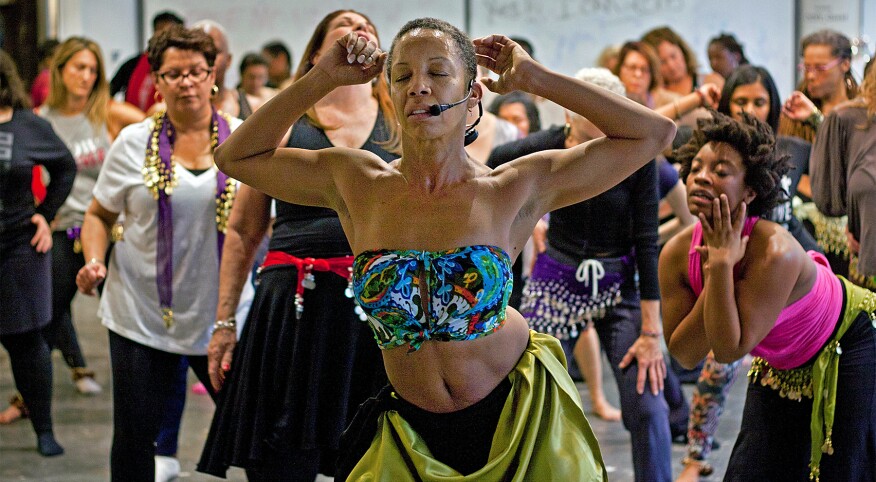Movement has always been a natural and pure form of expression for me, from taking modern dance as an adolescent to working up a sweat grooving to house music with my girlfriends in college. In my grown and sexy years, I continue to move and shake in Zumba or African dance classes or prancing around the apartment, catching major side-eye from my cat.
While sheltering in place, however, I became less active and noticed more stiffness in my hips and lower back. With indoor dance classes on hold indefinitely and less opportunity for me to travel for an active and therapeutic wellness retreat, I needed to find an online alternative.
So when the Shift Network’s “Somatic Dance for Emotional Alchemy” workshop popped up in my Instagram feed several times, I applied for and received a partial scholarship. I was motivated to make the investment in myself because it was led by a Black woman, and I was eager to try somatic therapy. This practice is grounded in the relationship between the mind and the body and aims to release constricted emotions and calm the nervous system. After being cooped up for several months, I needed to find an effective way to diffuse my pandemic paranoia and simmering rage exacerbated by racial injustice. I also desired deeper connection and improved communication with my spouse. I wondered if somatic movement could help me with these emotions and relationship goals.
The empowering workshop includes a live drummer and sensual moves and techniques geared to create more emotional and physical freedom and new possibilities in relationships.
Research shows that dance can promote emotional, social, cognitive and physical integration and improve your overall health and well-being. And we already know that aerobic exercise can lessen depression and anxiety, lower your risk of type-2 diabetes and strengthen your bones and muscles.
For seven consecutive Wednesdays, I treated the hour and a half somatic dance sessions, facilitated by somatic healer Bernadette Pleasant via Zoom, like a mini retreat. The word soma means body in Greek, and while the body of evidence is small, the theory behind somatics is that it can help to process and release trauma. Somatic movements, touted Pleasant’s course description, offers “a powerful and easy way to release constricted emotions, calm your nervous system and step more confidently into your authentic self.”
A vibrant 55-year-old sister with short salt-and-pepper natural hair, fly eyeglass frames, color coordinated yoga wear and a spitfire personality, Pleasant seems fully in the moment and comfortable in her skin. Her empowering workshop includes a live drummer and sensual moves and techniques geared to create more emotional and physical freedom and new possibilities in relationships. During the virtual course, she takes participants on an emotional tour to get in touch with feelings like fear, grief, anger, shame, lust, flirtatiousness and joy that are bubbling under the surface.
“I speak to individuals who have been silenced, shut down, suppressed and unexpressed,” says Pleasant, adding that she does not teach dance, but rather “creates a container for non-judgmental movement.”
Pleasant, who has been a somatic healer for 11 years, asks participants to close their eyes, release their inhibitions and to move to their own rhythm. “Freedom in body movement is like that loud person in the choir who is having more fun than all those who are trying to hit notes,” she says. “I love teaching adults, but sometimes I have to remind them of that child that did not care; that child who just thought they were fabulous. They didn’t have to know how to do anything. They were just in it for the joy of it, the expression of it.”
During my “Somatic Dance for Emotional Alchemy” experience, I enjoyed winding my hips, flexing my feet, rolling on the floor and stretching my limbs to the African drum rhythms and hearing and sharing revelations with a virtual community of women from all races, ages and walks of life. One elder in her 70s voiced that she was entering a new relationship and wanted to “be alive” for it. I was touched by her vulnerability, and I had my own aha moment when Pleasant asked us to write down statements we needed to hear from someone that had not been expressed. What came up for me was, “I believe you.” Bringing that revelation to the surface, my eyes welled up with tears and I felt tingles throughout my body. Somewhere in my subconscious I needed to feel vindicated and validated. This was an unexpected emotional release and one that I had not experienced in talk therapy.
Haven’t you noticed how your body reacts to certain thoughts and feelings? When you experience fear or anxiety, your body usually has a fight-or-flight response, causing your muscles to tense up and your heart rate and breathing to increase. Conversely, don’t you feel more confident when you stand up straight and happier and less stressed when you smile or laugh out loud? Pleasant explores this type of mind-body connection.
“This is medicine on so many levels. It’s a release, so that you can expand and take up a little more space when you step outside — and all that sass and ownership of self that goes with you. I get real righteous about this because I want it. And I want it more for Black women because I feel there’s such a need,” says Pleasant. “I slowly began to shed my own trauma and shame when I decided to leave my marriage and the strict religious confinement of Jehovah's Witnesses.”
“It’s scary to take up more space for fear of, “Did I just say or do that?” But it feels better than not doing it. Not doing it feels confined and tight, and it doesn’t feel like living my best life.”
Are you ready to try somatic dance and move to the beat of your own drummer? Here, Pleasant, founder of the Emotional Institute, offers three easy ways to get started:
- Ask your body what it needs. For example, “How can I feel joy in my feet? How would they move?” Then continue to ask and acknowledge different parts of your body.
- Slow down. “Take time to walk in nature, stretch slowly and shut everything off.”
- Make a playlist. Include your favorite meditative music and motivational songs. Or better yet, listen to a Sisters From AARP playlist, curated with self-care and Black Girl Joy in mind.











